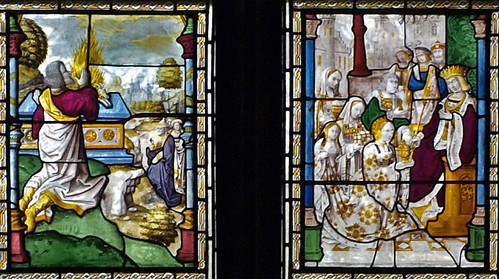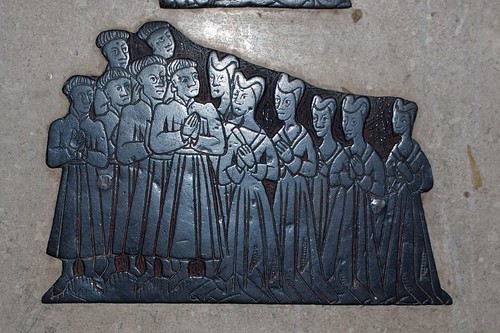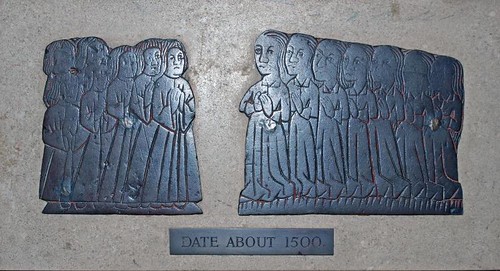ST PETER. A large church in a fine position and with a surprisingly big W tower of c. 1500, ashlar-faced, with angle buttresses, battlements and a higher stair turret. The medieval church behind it consisted of nave, chancel and N aisle. Its S and E walls survive, but heavily over-restored, when they were reduced to being the S aisle of a new church with its own large chancel which took the place of the former N aisle. The arcade is reconstructed but, it is said, correctly. With its circular piers and double-hollow-chamfered arches it represents a C13 model. Older still and fortunately preserved is the Norman S doorway. It has one order of columns with zigzag-carved shafts, a carved lintel, an arch with zigzag decoration, and a tympanum with diaper ornament, little squares divided into two triangles. The new church is of 1868, designed by Teulon. - FONT. 1662, polygonal, with thick leaves sprouting up the stem. - COMMUNION RAILS. Of iron, designed by Scott. - STAINED GLASS. Two late C15 panels in the W window, probably Flemish. - E window and S aisle E window by Kempe; 1886 and 1888. - PLATE. Cup of 1564; large Cup of 1635; Paten of 1686. - MONUMENTS. Set of Brasses at the W end; returned to the church in 1933. All small. Civilian of c. 1450; Woman and Children of c. 1450 (originally husband, three wives and three groups of children); Civilian of c. 1480; Kneeling Children of c. 1500; A. Crafford d 1606; Robert Picakis and Allen Talbott, two Kneeling Children d. 1634. - Hugh Smith d. 1757. Standing wall monument with sarcophagus and grey obelisk. Against it large roundel with two profiles facing one another. Unsigned.
SOUTH WEALD. It has a lovely walk through an old deer park, the path bringing us by a pleasant lake, and it is famous for old buildings. Weald Hall in the lovely park has been much refashioned, but has two 16th century wings, one with gables and solid-looking turrets, and one with a parapet and fine chimneys. Here sometime before she became queen lived the terrible Mary Tudor, and the lodge of the hall is known as Princess Mary’s Chapel. It stands by the road for all to see, with tall turrets, a fine doorway, and a broad window of seven lights. There are two old inns of the 15th and 18th centuries, and the 18th century Brook House.
High above the churchyard are the rookeries of the park, old but not so old as the church, which has Norman stones in its walls. It has been refashioned with modern windows, but has a Norman doorway carved with chevron and with old ironwork on its door. The door to the turret of the tower has been opening and shutting 500 years. In a window of the tower is medieval glass with two panels showing the Sacrifice of Abraham, and the Queen of Sheba in white and gold. In the tracery above are 17th century figures of four saints. On the wall of the tower is a medallion portrait of Francis Wollaston, a famous scientist who was vicar here a hundred years ago. He was Professor of Chemistry at Cambridge, where he was famous as an experimenter. The vicar who followed him for 53 years was the remarkable Charles Almeric Belli, a man of great energy who lived to be 95 and called in Sir Gilbert Scott to rebuild this nave and chancel. The oak chancel screen is the work of Scott, resembling a medieval screen. The chancel roof has a choir of angels. In the chapel beyond the gilt iron railings is a wooden cross from Flanders brought from the grave of Christopher Tower, who gave his life for us.
On the wall are brass portraits of an attractive group of children, little Robert Picakis aged seven, and Allen Talbot aged two, a bonny lad with curly hair who died in 1634. There are two groups of children in the clothes they wore in 1500, and a mother with 12 children of half a century earlier.
Lying here is the old owner of the manor, Lord Chief Justice Scroggs, bracketed equal-first with Jeffreys as one of the worst judges who ever disgraced the English bench. The son of an Oxfordshire butcher, he left Oxford an MA, and, preferring the Bar to the Church, escaped conviction for assault and battery during a drunken bout, reached the bench at 43, to become Charles the Second’s Lord Chief Justice in 1678.
There centred about this man the chief prosecutions in the bogus Popish Plot of Titus Oates, which, based on some petty Roman Catholic movement towards strengthening the position of that church in England, was magnified by Oates and his creatures into the story of a plot to assassinate Charles the Second and to massacre the Protestants. The part of Scroggs was to convict the prisoners, no matter how lowly or how exalted their status, to rant and roar them into silence, to act as prosecutor as well as judge, to maintain the evidence of Oates as little less than sacred, and to assert that any testimony advanced for the defence was blasphemous perjury.
All England was in a panic, for none doubted the truth of these fictions. Scroggs sent the innocent to the gallows in batches, adding insult and denunciation to the bitterness of the penalty to which he doomed them, asserting that it was better to hang one Papist than three felons. Titus Oates gave a political party its label, naming the opponents of the persecution Tory, after the Irish murderers of English settlers.
When the panic was at its height the accusers declared the queen and her physician to be implicated in the plot to murder the king; and a bill was laid before the grand jury naming the future James the Second as a Papist, to be excluded from the succession, and the king’s favourite the Duchess of Portsmouth as a public nuisance.
The tide had begun to turn; Scroggs’s heart failed him; he dismissed the grand jury before it could act. He now turned about, and acquitted persons falsely accused, traversed the evidence of Oates and his confederates, and was pilloried in broadsheets and publicly assaulted for his pains. Impeached for his offences, Scroggs was saved by Charles, who dissolved his Parliament and never summoned another; but he no longer dared to continue the unjust judge in office, retiring him with a pension of £1500 a year, to die two years later, in 1683, the scorn of his generation. Scroggs was a witty and powerful speaker, but without conscience or scruple, a paid ruffian of the Court, and a man of infamous private life. He is admirably pictured in Scott’s Peveril of the Peak, where he is shown after fear has taken possession of him and he knows not what to do with his prisoners.
Simon K -
Open. Another 19th Century extravaganza, this time by Samuel Teulon, although the patron was the same as for Bentley. This is a Victorian church on a grand scale, with a wide nave and south aisle, and room for hundreds and hundreds of people.
There is good glass by the Kempe workshop, and while stepping into the sanctuary to take a closer look I managed to set off the alarm. There was no warning sign. It was very loud indeed, with flashing lights as well as a siren. Luckily, I had just seen someone leave the church office in the extension, and they were still in their car outside, so I was able to let them know.
Flickr.
High above the churchyard are the rookeries of the park, old but not so old as the church, which has Norman stones in its walls. It has been refashioned with modern windows, but has a Norman doorway carved with chevron and with old ironwork on its door. The door to the turret of the tower has been opening and shutting 500 years. In a window of the tower is medieval glass with two panels showing the Sacrifice of Abraham, and the Queen of Sheba in white and gold. In the tracery above are 17th century figures of four saints. On the wall of the tower is a medallion portrait of Francis Wollaston, a famous scientist who was vicar here a hundred years ago. He was Professor of Chemistry at Cambridge, where he was famous as an experimenter. The vicar who followed him for 53 years was the remarkable Charles Almeric Belli, a man of great energy who lived to be 95 and called in Sir Gilbert Scott to rebuild this nave and chancel. The oak chancel screen is the work of Scott, resembling a medieval screen. The chancel roof has a choir of angels. In the chapel beyond the gilt iron railings is a wooden cross from Flanders brought from the grave of Christopher Tower, who gave his life for us.
On the wall are brass portraits of an attractive group of children, little Robert Picakis aged seven, and Allen Talbot aged two, a bonny lad with curly hair who died in 1634. There are two groups of children in the clothes they wore in 1500, and a mother with 12 children of half a century earlier.
Lying here is the old owner of the manor, Lord Chief Justice Scroggs, bracketed equal-first with Jeffreys as one of the worst judges who ever disgraced the English bench. The son of an Oxfordshire butcher, he left Oxford an MA, and, preferring the Bar to the Church, escaped conviction for assault and battery during a drunken bout, reached the bench at 43, to become Charles the Second’s Lord Chief Justice in 1678.
There centred about this man the chief prosecutions in the bogus Popish Plot of Titus Oates, which, based on some petty Roman Catholic movement towards strengthening the position of that church in England, was magnified by Oates and his creatures into the story of a plot to assassinate Charles the Second and to massacre the Protestants. The part of Scroggs was to convict the prisoners, no matter how lowly or how exalted their status, to rant and roar them into silence, to act as prosecutor as well as judge, to maintain the evidence of Oates as little less than sacred, and to assert that any testimony advanced for the defence was blasphemous perjury.
All England was in a panic, for none doubted the truth of these fictions. Scroggs sent the innocent to the gallows in batches, adding insult and denunciation to the bitterness of the penalty to which he doomed them, asserting that it was better to hang one Papist than three felons. Titus Oates gave a political party its label, naming the opponents of the persecution Tory, after the Irish murderers of English settlers.
When the panic was at its height the accusers declared the queen and her physician to be implicated in the plot to murder the king; and a bill was laid before the grand jury naming the future James the Second as a Papist, to be excluded from the succession, and the king’s favourite the Duchess of Portsmouth as a public nuisance.
The tide had begun to turn; Scroggs’s heart failed him; he dismissed the grand jury before it could act. He now turned about, and acquitted persons falsely accused, traversed the evidence of Oates and his confederates, and was pilloried in broadsheets and publicly assaulted for his pains. Impeached for his offences, Scroggs was saved by Charles, who dissolved his Parliament and never summoned another; but he no longer dared to continue the unjust judge in office, retiring him with a pension of £1500 a year, to die two years later, in 1683, the scorn of his generation. Scroggs was a witty and powerful speaker, but without conscience or scruple, a paid ruffian of the Court, and a man of infamous private life. He is admirably pictured in Scott’s Peveril of the Peak, where he is shown after fear has taken possession of him and he knows not what to do with his prisoners.
Simon K -
Open. Another 19th Century extravaganza, this time by Samuel Teulon, although the patron was the same as for Bentley. This is a Victorian church on a grand scale, with a wide nave and south aisle, and room for hundreds and hundreds of people.
There is good glass by the Kempe workshop, and while stepping into the sanctuary to take a closer look I managed to set off the alarm. There was no warning sign. It was very loud indeed, with flashing lights as well as a siren. Luckily, I had just seen someone leave the church office in the extension, and they were still in their car outside, so I was able to let them know.
Flickr.



No comments:
Post a Comment